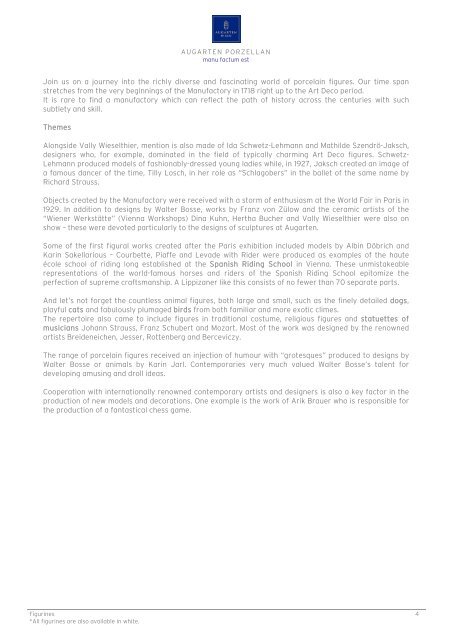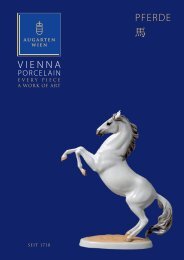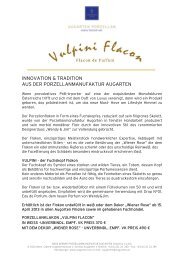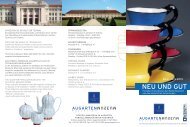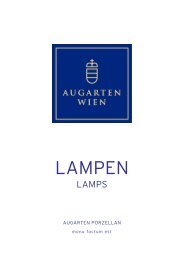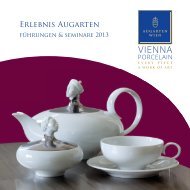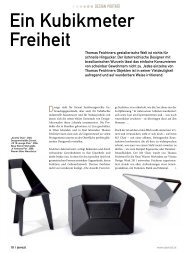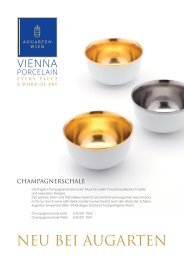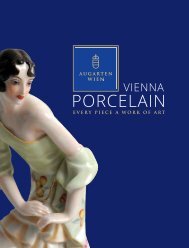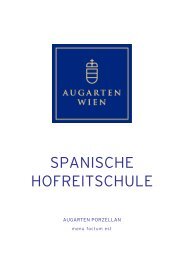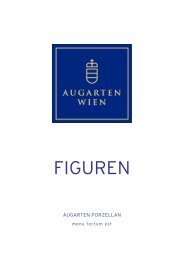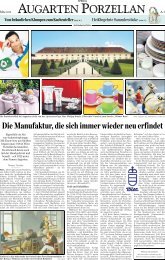Create successful ePaper yourself
Turn your PDF publications into a flip-book with our unique Google optimized e-Paper software.
AUGARTEN PORZELLAN<br />
manu factum est<br />
Join us on a journey into the richly diverse and fascinating world of porcelain figures. Our time span<br />
stretches from the very beginnings of the Manufactory in 1718 right up to the Art Deco period.<br />
It is rare to find a manufactory which can reflect the path of history across the centuries with such<br />
subtlety and skill.<br />
Themes<br />
Alongside Vally Wieselthier, mention is also made of Ida Schwetz-Lehmann and Mathilde Szendrö-Jaksch,<br />
designers who, for example, dominated in the field of typically charming Art Deco figures. Schwetz-<br />
Lehmann produced models of fashionably-dressed young ladies while, in 1927, Jaksch created an image of<br />
a famous dancer of the time, Tilly Losch, in her role as “Schlagobers” in the ballet of the same name by<br />
Richard Strauss.<br />
Objects created by the Manufactory were received with a storm of enthusiasm at the World Fair in Paris in<br />
1929. In addition to designs by Walter Bosse, works by Franz von Zülow and the ceramic artists of the<br />
“Wiener Werkstätte” (Vienna Workshops) Dina Kuhn, Hertha Bucher and Vally Wieselthier were also on<br />
show – these were devoted particularly to the designs of sculptures at <strong>Augarten</strong>.<br />
Some of the first figural works created after the Paris exhibition included models by Albin Döbrich and<br />
Karin Sakellarious – Courbette, Piaffe and Levade with Rider were produced as examples of the haute<br />
école school of riding long established at the Spanish Riding School in Vienna. These unmistakeable<br />
representations of the world-famous horses and riders of the Spanish Riding School epitomize the<br />
perfection of supreme craftsmanship. A Lippizaner like this consists of no fewer than 70 separate parts.<br />
And let’s not forget the countless animal figures, both large and small, such as the finely detailed dogs,<br />
playful cats and fabulously plumaged birds from both familiar and more exotic climes.<br />
The repertoire also came to include figures in traditional costume, religious figures and statuettes of<br />
musicians Johann Strauss, Franz Schubert and Mozart. Most of the work was designed by the renowned<br />
artists Breideneichen, Jesser, Rottenberg and Berceviczy.<br />
The range of porcelain figures received an injection of humour with “grotesques” produced to designs by<br />
Walter Bosse or animals by Karin Jarl. Contemporaries very much valued Walter Bosse’s talent for<br />
developing amusing and droll ideas.<br />
Cooperation with internationally renowned contemporary artists and designers is also a key factor in the<br />
production of new models and decorations. One example is the work of Arik Brauer who is responsible for<br />
the production of a fantastical chess game.<br />
Figurines 4<br />
*All figurines are also available in white.


